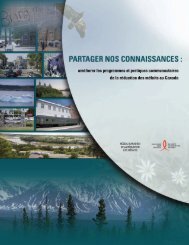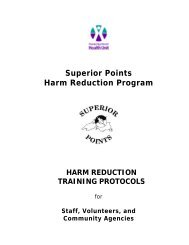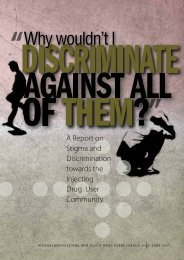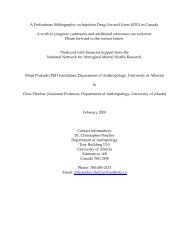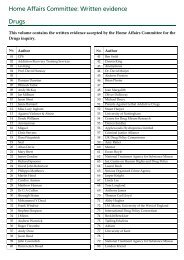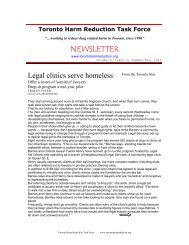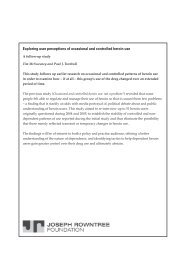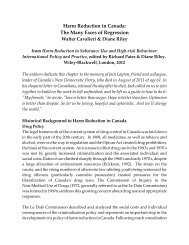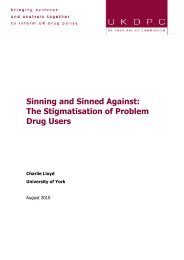9<strong>The</strong> US approach is traditionally reflected in much <strong>of</strong> Latin America where there is a significant variation in the proportion <strong>of</strong>the prison population detained for specific drug-related <strong>of</strong>fences. Unsurprisingly the highest proportions are to be found in theAndean region: Bolivia, Ecuador, Colombia and Peru. As in several other parts <strong>of</strong> the world there are also significant genderdifferences in Latin America, with drug-related <strong>of</strong>fences featuring much more significantly amongst women prisoners. Almost12% <strong>of</strong> prisoners in the Argentine federal system are women. More than 60% <strong>of</strong> them are detained for drugs <strong>of</strong>fences. A 2008census <strong>of</strong> Ecuador’s prisoners found that 70% <strong>of</strong> women prisoners were detained for drug-related <strong>of</strong>fences. 40Since that time there have been significant measures to reduce the prison population in Ecuador, including early release for certaincategories <strong>of</strong> drug <strong>of</strong>fender, particularly women who have acted as drug ‘mules.’ Article 364 <strong>of</strong> the new constitution forbids thecriminalisation <strong>of</strong> addictions. It is unclear what impact this may have on <strong>of</strong>fences <strong>of</strong> possession and supply <strong>of</strong> drugs.This represents a trend towards more liberal attitudes to recreational drug use in Latin America. In part prison overcrowding hashelped to s<strong>of</strong>ten policies on drug use, with Colombia, Mexico and Argentina moving to decriminalise small-scale possession forpersonal use while retaining harsh penalties for production and supply (Barrionuevo, 2009).OceaniaSome countries in this region have moved away from harsh laws and penalties. In Australia in particular the <strong>of</strong>ficial response todrug possession and use is primarily a civil procedure. In terms <strong>of</strong> prison demographics, the New Zealand Ministry <strong>of</strong> Justice hasrecently found that manufacturing, importing and selling Class A and B drugs are major contributors to prison growth. 41 Similarly,in Australia the majority <strong>of</strong> drug <strong>of</strong>fenders, that is to say those categorized as having their most serious <strong>of</strong>fence as an illicit drug<strong>of</strong>fence, were serving time due to import-export, dealing-trafficking and manufacture-cultivation <strong>of</strong>fences rather than “possessionand/or use.” 42 Meanwhile levels <strong>of</strong> drug use among prisoners are also high in Australia with almost 60% <strong>of</strong> prisoners reporting ahistory <strong>of</strong> injecting drug use in 2004. 43 Penalties for possession or use <strong>of</strong>, or trafficking in illegal drugs in pacific countries suchas Papua New Guinea and the Solomon islands are severe, and convicted <strong>of</strong>fenders can expect long jail sentences and heavy fines.Data for these countries is not available however.AfricaAlthough one fifth <strong>of</strong> the world’s population lives in Africa and more than a quarter <strong>of</strong> all countries in the world are in Africa, thecontinent is, by far, the least documented region in terms <strong>of</strong> data and information on crime and drugs. Many African Governmentsare unable to supply information on the situation <strong>of</strong> drugs and crime in their country, including information requested byinternational drug and crime control treaties. Not surprisingly data on drugs and imprisonment are scarce in respect <strong>of</strong> Africancountries. UNODC have estimated that the proportion <strong>of</strong> drug users in the prison population in the 1990’s ranged from 90% inNamibia to 3% in Nigeria with drug related convictions in the early 2000’s ranging from 3.3% in Ethiopia to 56% in Mauritiusbutthere are questions about the reliability <strong>of</strong> the data. 4440 Official release from the Ministry <strong>of</strong> Justice and Human Rights: www.minjusticia-ddhh.gov.ec/index.php?option=com_content&task=view&id=89&Itemid=141 Provoost D above42 Australian Bureau <strong>of</strong> Statistics, Prisoners in 2008 http://www.ausstats.abs.gov.au/ausstats/subscriber.nsf/0/86E255C8FD635DE6CA25751B0014692E/$File/45170do024_2008.xls43 Statistics on <strong>Drug</strong> Use in Australia 2006 Australian Institute for Health and Welfare44 Reychad Abdool Reducing HIV/AIDS infection in prisons. Paper to CESCA Conference Nairobi August 2005
10BENEFITS OF INCARCERATIONHaving presented an overview <strong>of</strong> the scale and demographic makeup<strong>of</strong> incarceration <strong>of</strong> drug <strong>of</strong>fenders in the USA, we now move onto attempt to assess the potential drug prevention benefits <strong>of</strong> such apolicy. Discussion examines the specific elements <strong>of</strong> incapacitation,rehabilitation and deterrence, and attempts to assess the overall impact<strong>of</strong> incarceration on reducing levels <strong>of</strong> illicit drug use.Incapacitation<strong>The</strong>re is some evidence to suggest that domestic enforcementcould reduce drug consumption by directly lowering demand. Putsimply, if drug users are incarcerated they are not contributing tothe illicit drug market outside <strong>of</strong> prison. Additionally, since mostdrug sellers are also users, the incapacitation <strong>of</strong> sellers could reducethe number <strong>of</strong> active buyers (Boyum & Reuter, 2005), although itshould be noted that wholesale suppliers and importers who are thepowerful players in the market are rarely drug users. It is, however,difficult to find a correlation between trends in incarceration and areduction <strong>of</strong> the market since research suggests that the US stateswith higher rates <strong>of</strong> drug related incarceration experienced highernot lower rates <strong>of</strong> drug use (Justice Policy Institute, 2000). Suchdiscussions also ignore the existence <strong>of</strong> sizeable markets withinmany prisons worldwide. For example, a 2003 report estimated that12%-60% <strong>of</strong> inmates housed in European prisons had used drugsduring incarceration (ECMDDA, 2003). A more recent Germanstudy found that 75% <strong>of</strong> imprisoned injection drug users continuedto inject in prison (Stark, et al, 2006).RehabilitationA large-scale review <strong>of</strong> research on imprisonment carried out for theCanadian government found that <strong>of</strong>fenders who were imprisonedwere no less likely to re<strong>of</strong>fend than those given communitysentences. Furthermore, those given longer sentences were morelikely to go back to crime (Stevens, Trace, Bewley-Taylor, 2005).Indeed, it is virtually universally accepted that imprisonment initself does not have a reformative effect, but that certain kinds<strong>of</strong> treatment programme can have a significant effect in reducing<strong>of</strong>fending behaviour among certain groups <strong>of</strong> individuals (Dunbarand Langdon, 2002). This obviously has particular relevance to drugusers. Comparisons <strong>of</strong> US studies <strong>of</strong> a wide range <strong>of</strong> communitybased programmes and in-prison treatment programmes includingmethadone maintenance treatment and substance abuse educationreveal similar success rates (Prendergast, Podus, Chang & Urada,2002, Pearson & Lipton, 1999). It is crucial to note, however, that somestudies show that similarities in success rates only apply to in-prisontherapeutic communities for which aftercare after imprisonment isa very important component <strong>of</strong> success (Inciardi, Martin, Butzin,Hooper & Harrison, 1997). On the other hand, Welsh (2007) foundthat treatment in a Prison <strong>The</strong>rapeutic Community significantlyreduced recidivism even where community aftercare was absent. Itdid not, however, reduce “drug relapse”. It should also be noted thattherapeutic communities are not generally available in prisons. Inmost cases, diversion from prison into community based treatment islikely to provide greater treatment benefits than imprisonment. Forexample, the <strong>Drug</strong> Treatment Alternative to Prisons programme inNew York found that only 26% <strong>of</strong> <strong>of</strong>fenders diverted into treatmentwere reconvicted, compared to 47% <strong>of</strong> comparable <strong>of</strong>fenders whowere sent to prison (National Center on Addiction and SubstanceAbuse, 2003). It would seem, therefore, that imprisonment presentsan opportunity for effective rehabilitation <strong>of</strong> drug addicts, but thatequally successful treatment can be delivered more easily, andcheaply, outside <strong>of</strong> prison.DeterrenceImpacts on <strong>Drug</strong> DealersIn their 2005 study, Boyum and Reuter conclude that US domesticenforcement, particularly low-level enforcement, does have animpact on levels <strong>of</strong> illicit drug use. This has much to do with thefact that the risks <strong>of</strong> incarceration are distributed over much smallerquantities <strong>of</strong> drugs for street level retail dealers. For example, aretailer handling a gram <strong>of</strong> cocaine faces a prison sentence thatmight be one-quarter <strong>of</strong> that faced by a high-level dealer handling1000 grams. Boyum and Reuter suggest that about 90% <strong>of</strong> the retailprice <strong>of</strong> cocaine and heroin represents price mark-ups within the US.This figure reflects an economic reaction, or market distortion, tothe risks faced by dealers in terms <strong>of</strong> arrest and imprisonment. Anincrease in the price <strong>of</strong> the illicit drug subsequently has an impact onprevalence rates because some users are unwilling to pay the highprices. <strong>The</strong> 90% mark-up would seem to suggest a high risk factor.Indeed, a RAND study <strong>of</strong> the District <strong>of</strong> Columbia estimated that in1988 street dealers faced about a 22% probability <strong>of</strong> imprisonmentin the course <strong>of</strong> a year’s selling and that given the expected amount<strong>of</strong> time served, they spent around one-third <strong>of</strong> their selling careersin prison. At first glance one-third <strong>of</strong> a career in prison does seem tomake drug dealing a high risk pursuit. However, closer inspectionreveals that the risk per sale may actually be small. A seller whoworks only two days per week may make 1,000 transactions a year.<strong>The</strong> imprisonment risk per transaction in the 1988 study couldtherefore be calculated to be only about 1 in 4,500. By that measureeach transaction would be a great deal less risky than for exampleburglary or robbery with expected cell-years per dollar earned beinglow relative to property crimes (Boyum & Reuter, 2005).It is also possible to assess risk in terms <strong>of</strong> aggregate figures.American users consume an estimated 300 tons <strong>of</strong> pure cocaine ayear. If sold in 0.2 gram units the volume would involve 1.5 billiontransactions. This would generate fewer than 1000 prison sentences,or less than a 1 in 15,000 risk <strong>of</strong> imprisonment per sale (Boyum &



